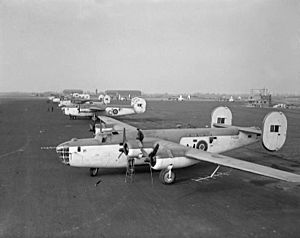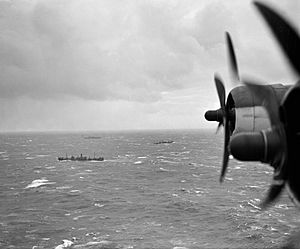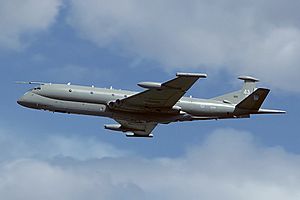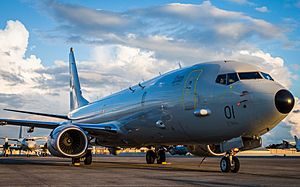No. 120 Squadron RAF facts for kids
Quick facts for kids No. 120 Squadron RAF |
|
|---|---|
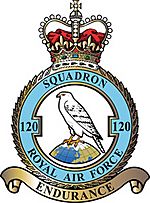
Squadron badge
|
|
| Active | 1 January 1918 – 1 April 1918 (RFC) 1 April 1918 – 21 October 1919 (RAF) 2 June 1941 – 4 June 1945 1 October 1946 – 26 May 2011 1 April 2018 – present |
| Country | |
| Branch | |
| Type | Flying squadron |
| Role | Anti-submarine warfare, anti-surface warfare and maritime patrol aircraft |
| Part of | No. 1 Group |
| Home station | RAF Lossiemouth |
| Motto(s) | Endurance |
| Equipment | Boeing Poseidon MRA1 |
| Battle honours |
|
| Insignia | |
| Squadron badge heraldry | Standing on a demi-terrestrial globe, a falcon close. The falcon, an Icelandic falcon, commemorates the squadron's stay there and also indicates the squadron's predatory instinct. |
| Squadron codes | OH (Jun 1941 – Dec 1941, Jul 1944 – Jun 1945) BS (Oct 1946 – Mar 1951) (Codes taken over from No. 160 Sqn) A (Mar 1951 – Apr 1956) 120 (Apr 1956 – Feb 1971?) |
No. 120 Squadron is a special flying unit of the Royal Air Force (RAF). It was first created during World War I as part of the Royal Flying Corps. After that war, it was closed down, but then it was started up again during World War II as part of RAF Coastal Command.
For many years, the squadron flew planes that patrolled the seas. These planes looked for enemy submarines and ships. One of its most famous planes was the Hawker Siddeley Nimrod. This plane was based at RAF Kinloss in Scotland until 2010.
No. 120 Squadron was closed again in 2011. However, it was reformed in April 2018 at RAF Lossiemouth. It became the first RAF squadron to fly the new Boeing Poseidon MRA1 aircraft. This happened on October 31, 2019. The Poseidon is a powerful plane used for finding and fighting submarines.
Contents
History of No. 120 Squadron
Early Days in World War I
No. 120 Squadron began on January 1, 1918, at Cramlington. It was supposed to be a unit that flew Airco DH.9 bomber planes. But World War I ended before the planes arrived. So, in 1918 and 1919, the squadron mostly flew communication and mail flights in Europe. It was then closed down on October 21, 1919.
Fighting U-boats in World War II
The squadron was started again on June 2, 1941. It became part of Coastal Command in Northern Ireland at RAF Nutts Corner. Its main job was to fight against German U-boat submarines in the Battle of the Atlantic. These submarines were a big threat to ships carrying supplies.
The squadron used Consolidated Liberator planes. They flew from bases in Northern Ireland and Iceland. No. 120 Squadron was very good at this job. It sank 14 U-boats completely by itself. It also helped sink three more and damaged eight others. This was the highest number of U-boat kills for any squadron in Coastal Command. The squadron also helped during Operation Overlord, which was the Allied invasion of France in 1944.
After the war in Europe ended in May 1945, the squadron was closed down again on June 4, 1945.
From Cold War to 2011 Operations
No. 120 Squadron was reformed on October 1, 1946. It took over from another squadron, No. 160 Squadron, at RAF Leuchars. At first, it flew Avro Lancaster planes. From November 1947 to February 1948, a part of the squadron worked in Palestine. They searched for ships carrying illegal immigrants.
In April 1951, the squadron started using Avro Shackleton MR.1 planes. On January 15, 1952, King George VI gave No. CXX Squadron its special "Standard" flag. This was a great honor because squadrons usually need 25 years of service to get one. No. 120 Squadron was one of only two squadrons to receive this early.
The squadron moved to its new base, RAF Kinloss, in Scotland on April 1, 1959. It continued to fly Shackleton planes until February 1971.
In October 1970, No. 120 Squadron began to use the Hawker Siddeley Nimrod MR.1. In 1973, the squadron flew missions during the Second Cod War with Iceland. In April 1981, the squadron started getting the improved Nimrod MR.2 planes.
In 1982, the squadron was the first Nimrod MR.2 unit to go to Wideawake Airfield on Ascension Island. From there, it flew missions during the Falklands War. On August 12, 1990, the squadron went to Seeb International Airport in Oman. It then took part in Operation Granby the next year.
The Nimrod MR.2 planes were taken out of service on March 31, 2010. The squadron was officially closed down on May 26, 2011.
The Poseidon Era (2019–present)
In July 2017, it was announced that No. 120 Squadron would be the first RAF squadron to fly the Boeing P-8A Poseidon. These planes would be based at RAF Lossiemouth. No. CXX Squadron was reformed on April 1, 2018.
The first Poseidon MRA1 plane, named ZP801, was given to the squadron on October 31, 2019. It arrived at Kinloss Barracks in Scotland on February 4, 2020. This plane was later named Pride of Moray. The RAF announced that the Poseidon MRA1s were ready for combat on April 1, 2020.
On August 3, 2020, No. 120 Squadron flew its first mission with the P-8A. The plane ZP801 followed a Russian warship called Vasily Bykov in the North Sea. The Poseidon planes moved to their permanent home at RAF Lossiemouth in October 2020. By January 2022, all nine of the new Poseidon aircraft had arrived.
Aircraft Used by No. 120 Squadron
- Airco DH.9 (1918 – 1919)
- Consolidated Liberator GR. I (1941 – 1943)
- Consolidated Liberator Mk. II (1941 – 1942)
- Consolidated Liberator Mk. III (1942 – 1944)
- Consolidated Liberator Mk. IV (1943 – 1945)
- Consolidated Liberator Mk. VI (1944 – 1945)
- Consolidated Liberator Mk. VIII (1944 – 1945)
- Avro Lancaster ASR.3 (1946 – 1951)
- Avro Lancaster GR.3 (1946 – 1951)
- Avro Shackleton MR.1 (1951 – 1956)
- Avro Shackleton MR.2 (1953 – 1954; 1956 – 1958)
- Avro Shackleton MR.3 (1958 – 1971)
- Hawker Siddeley Nimrod MR.1 (1970 – 1982)
- Hawker Siddeley Nimrod MR.2 (1981 – 2010)
- Boeing Poseidon MRA1 (2019 – present)
Names of the Poseidon Planes
The RAF's Poseidon MRA1 planes are given special names:
- ZP801 – Pride of Moray
- ZP802 – City of Elgin
- ZP803 – Terence Bulloch DSO* DFC*
- ZP804 – Spirit of Reykjavík
- ZP805 – Fulmar
- ZP806 – Guernsey's Reply
- ZP807 – William Barker VC
See also
- List of Royal Air Force aircraft squadrons


